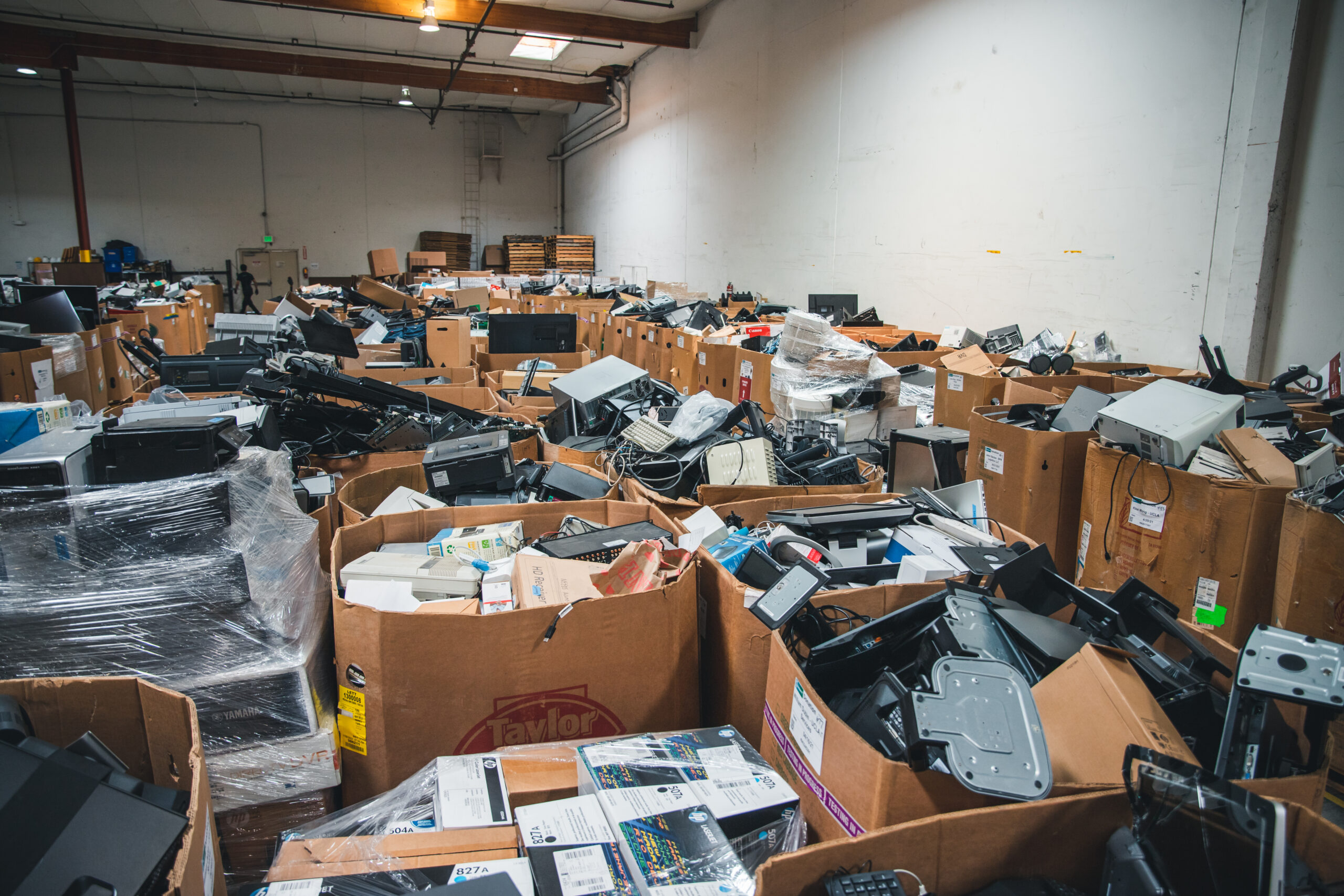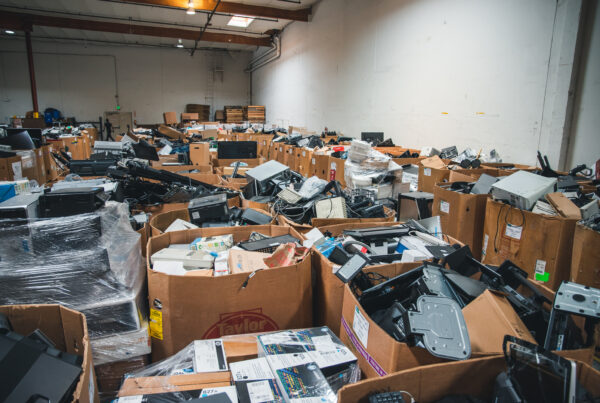Last updated: July 2025
According to IBM’s research, in 2024, data breaches cost organizations an average of $4.88 million. It’s a 10% spike from 2023! Not to mention 62 million tons of e-waste entered disposal systems with minimal security oversight. This means that e-waste cybersecurity issues could easily impact your organization.
Meanwhile, Verizon’s 2024 Data Breach Investigations Report found that human error contributes to 28% of all breaches—and improper device disposal ranks among the top preventable mistakes.
Your old devices are environmental hazards and security time bombs waiting to detonate your organization’s reputation and finances.
Traditional e-waste disposal offers zero data security guarantees. That “recycled” laptop could end up in the hands of someone actively hunting for your passwords, financial records, and client information. But there’s a solution that protects your data, saves money, and creates positive social impact.
Table of Contents
- The Hidden E-Waste Cybersecurity Crisis
- 2025’s Emerging Threats: AI and IoT Disposal Risks
- Current Data Destruction Standards That Actually Work
- 5-Step E-Waste Cybersecurity Protocol for Secure E-Waste Disposal
- Why Donation Beats Recycling for Security
The Hidden E-Waste Cybersecurity Crisis
When you delete files or perform a factory reset, you’re not actually erasing data. You’re simply telling the device to ignore those files—but they remain fully recoverable with basic software tools available online.
The UN’s 2024 Global E-Waste Monitor out of the e-waste generated in 2022, only 22.3% received proper handling. That leaves 48 million tons of potentially data-rich devices floating through informal recycling chains with zero security oversight.
The financial stakes keep climbing. Healthcare organizations now face average breach costs of $9.77 million, while financial services see $6.08 million per incident. One carelessly discarded device containing client records could trigger regulatory fines, lawsuits, and permanent reputation damage.
Even worse? Credential-based attacks account for 16% of all breaches, taking an average of 292 days to detect and contain. Your discarded laptop might be feeding these attacks right now.
2025’s Emerging Threats: AI and IoT Disposal Risks
The e-waste cybersecurity landscape is evolving faster than disposal practices. Asimily’s 2024 IoT Security Report documents how IoT devices reached 18.8 billion units globally, each representing a potential entry point for attackers.
Smart office equipment, industrial sensors, and AI-enabled devices store more sensitive data than traditional computers. They also lack robust security features, making proper disposal even more critical. November 2024’s “Matrix” botnet attack demonstrates how cybercriminals actively hunt discarded IoT devices to build massive attack networks.
Cryptocurrency wallets present another growing concern. Devices may contain wallet files worth thousands—or millions—of dollars. FTC data shows investment scam losses reached $5.7 billion in 2024, with many cases involving recovered digital assets from improperly disposed devices.
Current Data Destruction Standards That Actually Work
The gold standard for secure data destruction is NIST 800-88 Revision 1, which outlines three sanitization levels based on data sensitivity:
Clear: Overwrites data using standard read/write commands. Suitable for internal reuse of devices with low-sensitivity data.
Purge: Applies advanced techniques like cryptographic erase or multiple overwrite passes. Required for devices that handled confidential information before leaving your organization.
Destroy: Physical destruction of storage media. Mandated for classified data or when other methods aren’t feasible.
CISA’s 2024 guidance emphasizes that organizations must document every step of the sanitization process. This includes certificates of destruction, serialized reporting, and chain-of-custody documentation—requirements that standard recycling rarely provides.
5-Step E-Waste Cybersecurity Protocol for Secure E-Waste Disposal
Step 1: Inventory and Classify Your Devices
Create a comprehensive list of all devices scheduled for disposal. Categorize them by data sensitivity levels—public, internal, confidential, or restricted. This classification determines which NIST 800-88 method you’ll need.
Don’t forget hidden storage: printers with hard drives, network equipment with configuration files, and smart devices with cached credentials. Each requires individual assessment.
Step 2: Choose NAID AAA-Certified Service Providers
Partner exclusively with NAID AAA-certified organizations like Human-I-T that follow strict data destruction protocols. These certifications ensure your provider uses NIST 800-88 compliant methods and maintains proper documentation.
Verify their facility security, employee background checks, and chain-of-custody procedures. Request references from organizations in your industry, especially if you handle regulated data like HIPAA or financial records.
Step 3: Implement Secure Transportation
Never transport data-bearing devices in personal vehicles or use unsecured shipping. Professional ITAD providers offer GPS-tracked pickup services with tamper-evident packaging and real-time monitoring.
For remote employees, coordinate with your ITAD partner to provide secure shipping materials and clear instructions. Some organizations require on-site data destruction before devices leave the premises.
Step 4: Document Everything
Demand comprehensive reporting for every disposed device. This includes:
- Certificate of data destruction with technician signatures
- Serialized reports showing device-specific sanitization methods
- Environmental impact documentation for sustainability reporting
- Chain-of-custody records from pickup through final disposition
These documents prove compliance during audits and provide legal protection if questions arise later.
Step 5: Verify and Follow Up
Don’t assume the process worked correctly. Review all documentation for completeness and accuracy. For high-value disposals, consider requiring video documentation of the destruction process.
Establish ongoing relationships with certified providers rather than shopping around for each disposal event. This builds accountability and ensures consistent security standards.
Why Donation Beats Recycling for Security
Here’s what most organizations don’t realize: donation through certified nonprofits actually provides stronger e-waste cybersecurity than commercial recycling.
Organizations like Human-I-T combine enterprise-grade data destruction with social impact. They follow the same NIST 800-88 standards as commercial vendors but add community benefit. Your disposed devices get fresh operating system installations and quality testing before reaching families who gain access to digital literacy training.
The financial benefits are substantial too. Certified nonprofits provide tax-deductible receipts that often exceed disposal costs. You eliminate pickup fees while supporting digital equity initiatives that strengthen your ESG reporting.
Most importantly, donation keeps functional devices in circulation longer, reducing demand for new manufacturing. The UN estimates that proper e-waste management could generate $38 billion in global benefits by 2030—and your organization can be part of that solution.
Ready to secure your e-waste disposal? Human-I-T offers comprehensive ITAD services with NAID AAA-certified data destruction, secure pickup, and detailed impact reporting. Contact us today at 888-391-7249 to protect your data while creating positive community impact.
Learn more about our complete e-waste services and see our impact in communities nationwide.






